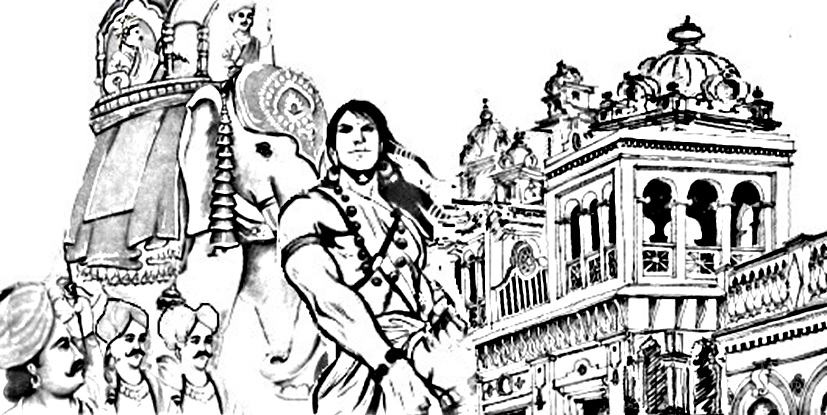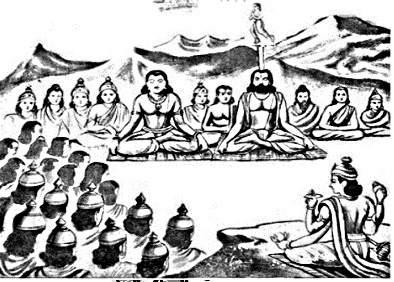
– Santhipriya –
With Sudarshan ascending the throne, the doors of doom opened for the end of Raghu lineage.Though Sudarshan was young when ascended the throne, he was as fast as others in absorbing the arts of ruling in all sincerity and earned the name mighty King in a short time. His qualities shone like great blue stone in the midst of sapphire, like a fiery Lion, King in Jungle. Fondly admired as Maharaja, as he grew with flower of youth, charm of loveliness spread over his body, his beauty far excelled, he became charm for women’s love, thus slowly absorbing the Kingly qualities of sensual pleasure into his mind and character. Exponent of Kamasuthra he was much sought after by women.
After years of glorious rule end enjoying the earthly life, Sudarshan, fed up in life, handed over the throne to his son Agnivarunan and retired to Naimisaranya’s grove to lead life of peace in the last stages of life. When Agnivarunan sat in saddle, his foes remained crushed, unable to revolt, there was no dearth of funds to administer, rules and regulations were well laid out to ensure effective functioning and his subjects lived in peace, free of concerns from others. Thus Agnivarunan, free from concerns in governing and at the same time unconcerned of his peoples welfare, engaged himself entirely sensual pleasures and wasted his life in ignoble pursuits. No amount of counselling by the council of Ministers would check his pleasure seeking ways. As the days passed, his passion for sensual pleasure instead of waning, only increased thrusting incurable disease on him curbing even his movements and confining him to bed.
As Agnivarunan bore no offspring, gloom stuck the minds of the council on his successor. Even after several years since he ascended the throne, he did not meet folks and rarely met them when someone longed to meet him. Their attention was diverted to tell them that the King was in penance to beget a son and hid the fatal fact of the bedridden King’s incurable, chronic disease from them. As days moved, the King died.
Even after the demise of the King, the fact was kept under the wrap and they called a well skilled priest in funeral rites to enact a drama as if a sacrifice was underway and in the pyre lit, the dead body of the King was secretly laid and put to rest.

Next in haste they called a meeting and seated on throne the rightful Queen of the demised King, who carried beneath her breast all the royal qualities, since the dead King was left with no issue to rule beyond him. Sat in the royal throne and realizing the break in Raghu’s race, she however sagely ruled the state to flutter the flags of Raghu’s race and as she ruled, the folks in her land fully and willfully honoured all her commands issued. With this narration Kalidasa’s original Raghuvamsa got concluded abruptly. Beyond this, further manuscripts were found missing.
-Raghuvamsam- Random thoughts

Prior to Agnivarunan those who sat on the throne in Raghu’s lineage perished either ending their life their own or taking to austere life to reach jungle. Even as the spouse of Agnivarunan took to the reins, the folks lead happier life abiding to rules of law, law of rule transparently prevailed, but the break in the chain of link established by a maid instead of a male heir taking the reins in Raghu’s lineage was the last straw in the wind of Raghu lineage, however the rulers beyond the spouse of Agnivarunan remains shrouded in mystery even to this date.
Some scant documents available to scholars suggest that following Agnivarunan’s spouse, more than 35 rulers reined in solar dynasty’s Ikshavaku lineage, the last amongst them being King Sumatra who reportedly ruled North of Surat in Gujarat, but his history is also unavailable and remains sketchy. Strangely there remains firm belief that in the yugas to come Maru son of one Shikraghu, who took to the reins after the demise of Agnivarunan’s rulers and who excelled in the art of Yoga shall born again in Kaliyug to re-establish Raghu dynasty. However details like whether he belonged to the lineage of Agnivarunan’s spouse or someone else remains vacuum. Therefore some of the scholars believe that Maru could be one of the leafs of pre Agnivarunan’s rulers as every first leaf in the ruler dynasty occupied the Realm after their father’s demise in Raghu’s lineage and the fate of seconds or thirds never debated upon. Similarly some stories suggest that the eight in line of the rulers after Maru’s rein was one King Brahathpal who reportedly aligned with Gowravas and fought for them in the war against Pandavas and killed by Abhimanyu in the Mahabharata war. But again none of these episodes figure anywhere in Kalidasa’s Raghuvamsa or in Valmiki Ramayana.
However based on Kalidasa’s Raghuvamsa, the lineages of Lord Rama, both before him and after him were as below:
1) Dilipa
2) Raghu
3) Ayan
4) Dasaratha
5) Rama
6) Lava
7) Kusa
8) Athithi
9) Nishadha
10) Nala
11) Nabha
12) Pundarika
13) Kshemadha
14) Devanika
15) Ahinahu
16) Pariyathra
17) Sila
18) Kusa (Not from Lava and Kusa)
19) Unnabha
20) Vajranabha
21) Visuvadasa
22) Hiranyanabha
23) Sanganain
24) Viyoshidasa
25) Adhyathma
26) Kausala
27) Brahmishtha
28) Dhuruvasanthi
29) Sudarshan
30) Agnivarunan
31) Agnivarunan’s wife
Kalidasa’s Raghuvamsa ends abruptly with Agnivarunan beyond which details of the rulers in Raghu dynasty remained blanked. It is quite possible that the same could have been scribbled in the untraced pages of Kalidasa’s Raghuvamsam, so conjectures the scholars. There is yet another interesting story connected to Kalidasa’s Raghuvamsam.
Kalidasa was one of the gems in Ujjain King Bhoja Raja’s council of ministers and both held deep rooted relationship. However they often discarded when in anger Kalidasa used to remain incognito for some time before re-joining with the king again when their head cooled. Once such an occasion arose and Kalidasa left the King, remaining untraced for a long period.
Kalidasa while in hiding stayed with a whore and claiming himself to be a poet. Though Kalidasa served in the courtyard of the King, very few have only met him, while others have only heard of him, lo, even most of the intelligencers (spies) have not seen the face and hence it was tough to track Kalidasa whenever he remained elusive.
Aware of the difficulties involved in tracing his missing friend Kalidasa, the worried King Bhoja, eager to meet his friend and guide in literary field, played a ploy to trace the location of Kalidasa, and announced huge bounty to those who rip open the riddle of the King, as the King was sure that none except Kalidasa can unravel the knot and once when someone comes with an answer, then Kalidasa’s hideout can be tracked.
The whore with whom Kalidasa stayed was wicket in nature and she decided to enrich exploiting the talent of the stranger poet and approached him seeking solution to crack the riddle to get the bounty, and unwitting Kalidasa gave the whore a verse in Sanskrit that unraveled the knot of the puzzle. Thus got the true answer, the dubious whore quietly murdered him while in sleep by slicing his head in order to ensure that he may not approach the King beforehand claiming the bounty.
Next when she went to the Palace and submitted the verse in answer to the riddle and claimed the bounty, from the composition the King understood that only Kalidasa would have unraveled it and though released the bounty to her, pressurized her to tell the wizard who solved the riddle. On learning the entire news, the next thing the King did was to rush with her to bring to life his dragoman Kalidasa whom he longed to see so long. Bhoja possessed a special magic power with which even the dead can be revived and retained for a few hours. Now on reaching the house of the whore where the dead body of Kalidasa lay, Bhoja quickly applied his power to awaken him.
As Kalidasa raised up as though he got up from sleep, both hugged each other and wept uncontrollably. Kalidasa reminded Bhoja that time available for him to remain alive being short, Bhoja should complete the unfinished Raghuvamsam with the unutilised briefs held by him (Kalidasa) and instantly gave them to Bhoja. In minutes of passing on the briefs Kalidasa fell dead again and Bhoja in morose took the grief in boldness and commenced compiling Raghuvamsam afresh again, yet he too could not complete it and the incomplete version came to be later known as epic Bhoja Sambu. It was quite strange that even the compilation of Bhoja Sambu ended abruptly for unknown reasons with the episode of Agnivarunan, same as Kalidasa’s Raghuvamsam, others remained untraceable.
Kalidasa’s Raghuvamsam dealt Rama’s predecessors and successors in general including their sins and dooms of previous births, but it remained silent on the divinely aspect of Rama. Since Kalidasa has referred Valmiki Ramayana in his work, the scholars surmise that he may have read Valmiki Ramayana in original before composing Raghuvamsam. Again the scholars while suggesting that the Valmiki Ramayana in original consisted of 24000 verses describing in lucid the birth to death of Rama without incorporating details either on Rama’s predecessors or his successors also mention that in the said compilation, the details of Pre Rama’s rulers and parts portraying end of Rama are not available. However the dissenting voices too in scholars suggest that the missing contents of Valmiki Ramayana may have contained Rama’s lineage in totality which may have remained as the main theme for Raghuvamsam. Like the controversy surrounding Valmiki Ramayana, there remains mystery angle in Raghuvamsam too. The scholars surmise that Kalidasa’s Raghuvamsam too contained 25 Cantos out of which only 19 Cantos are traceable and contents there in the remaining is unknown because Raghuvamsam ended abruptly with the rule of the spouse of Agnivarunan. Therefore the epic Raghuvamsam of today is not a complete document on Rama’s lineage and part of Rama’s history remains shouldered in mystery.
-Article concluded

